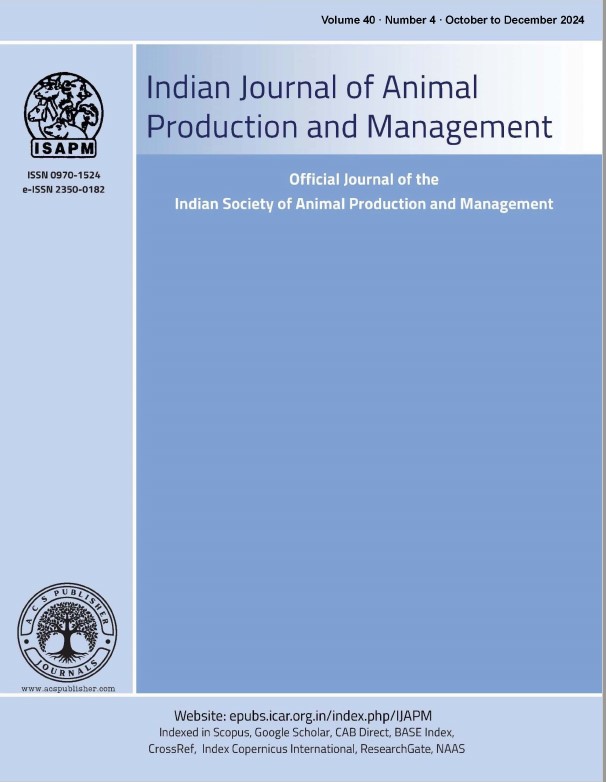Colostrum Yield and Colostrum Suckled by Neonatal Buffalo Calves
DOI:
https://doi.org/10.48165/ijapm.2024.40.1.4Keywords:
buffalo, neonatal calves, colostrum yield, colostrum suckledAbstract
The colostrum production by buffaloes during 12 h after post birth was measured in three intervals within 2 h after birth, 2 to 6 h after birth, and 12 h after birth, by weigh-suckle-weigh method and hand milked colostrum measured in measuring cylinder. Average colostrum suckled by neonatal calf of having average body weight 27.93 kg in first feeding at 2 h, 2nd feeding at 6 h and 3rd feeding at 12 h after birth were 275.63 mL, 413.13 mL and 656.31mL respectively and average total colostrum suckled by neonatal calves at 6 hours after birth calving and total colostrums suckled in 12 h after birth were 688.76 mL and 1345 mL respectively, with a total yield of 4112 mL of colostrum (suckled plus hand milked) equal to 14.72 % of body weight of the calf. It was found that the total colostrums yield at 6 h and 12 h of after birth (including hand milked and colostrums suckled) were 2252.40 mL and 1867.63 mL, respectively. It was recorded that, average colostrums suckled (per cent of body weight of calf) at 2 hours in first feeding, at 6 hours in 2nd feeding and at12 hours in 3rd feeding of after birth were 1.26, 1.47, and 2.46, respectively and average total colostrums suckled (per cent of body weight of calf) at 6 h after birth (including 1st feeding and 2nd feeding) and at 12 h after birth (includes all three feedings up to 12 h after birth) were, 2.34 and 6.68, respectively.
References
Arthington J.D.; Cattell M.B.; Quigley III; J.D. Effect of Dietary IgG Source (Colostrum, Serum, or Milk Derived Supplement) on the Efficiency of Ig Absorption in Newborn Holstein Calves J Dairy Sci. 2000. 83(7) p1463–1467.
Donovan G.; Arthur; Dohoo Ian R.; Montgomery David M.; Bennett Fred L. Associations between passive immunity and morbidity and mortality in dairy heifers in Florida, USA Preventive Veterinary Medicine. 1998. Vol. 34(1), pp.31–46 https://doi.org/10.1016/s0167-5877(97)00060-3 PMID: 9541949.
Furman-Fratczak K.; Rzasa A.; Stefaniak T. The influence of colostral immunoglobulin concentration in heifer calves’ serum on their health and growth. Journal of Dairy Science 2011. 94(11) pp 5536–5543. https://doi.org/10.3168/jds.2010-3253 PMID: 22032377.
Ganchev G; Yavuz E; Todorov N. Effect of feeding program for first two months after birth of female calves on growth, development and first lactation performance. Agricultural Science and Technology, 2015, Vol. 7(4), pp.389–401.
Hardy J; Daniels K. M; Winston D. R. The impact of amount and quality of colostrum and subsequent transition milk on calf health and growth. Journal of Animal Science, 2016, Vol. 94(suppl5), pp.20–20.
Krishnamoorthy, U and Moron J Rearing young ruminants on milk replacers and starter feeds. Food and Agriculture organisation manualon animal production and health. no: 13, 2011.
Lora I; Barberio A; Contiero B; Paparella P; Bonfanti L; Brscic M; et al. Factors associated with passive immunity transfer in dairy calves: combined effect of delivery time, amount and quality of the first colostrum meal animal, 2018 Vol. 12(5), pp.1041–1049.
Naik, M.C., Krishnamoorthy, U., Nagaraja, R. and Yathiraj, S.,2016. Lactating pattern in Mandya ewes and its influence on body weight gain in pre weaning lambs Ind. J. small rumin, 22(1):22-
Patel S., Gibbons J., Wathes D.C. Ensuring optimal colostrum transfer to newborn dairy calves. Cattle Practice. 2014. 22(1) pp 95–104 https://www.google.com/url?sa=t&rct=j&q=&esr
c=s&source=web&cd=1&ved=2ahUKEwjZ8_p8 s_jAhWeSxUIHQ8QCEgQFjAAegQIARAC&url =https%3A%2F%2Fdairy.ahdb.org.uk%2Fnon_ umbraco%2Fdownload.aspx%3Fmedia%3D17
&usg= AOvVaw2otqsl2ojY5RTv4HQx11Xv Accessed 31/7/19.
Raboisson D.; Trillat P.; Cahuzac C. Failure of Passive Immune Transfer in Calves: A Meta Analysis on the Consequences and Assessment of the Economic Impact. PLoS ONE. 2016. Vol. 11(3), p.e0150452 https://doi.org/10.1371/journal.pone.0150452 PMID: 26986832
Smith T; Little R. The significance of colostrum to the newborn calf. Journal of Experimental Medicine. 1922. 36(2):181–98 Accessed 31/7/19 https://doi.org/10.1084/jem.36.2.181 PMID: 19868663.

